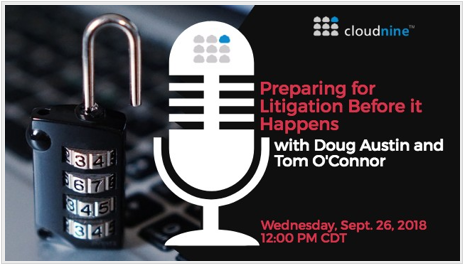Plaintiffs Granted Discovery Extension Due to Defendant’s TAR Review Glitch: eDiscovery Case Law
In the case In Re Domestic Airline Travel Antitrust Litigation, MDL Docket No. 2656, Misc. No. 15-1404 (CKK), (D.D.C. Sept. 13, 2018), District of Columbia District Judge Colleen Kollar-Kotelly granted the Plaintiffs’ Motion for an Extension of Fact Discovery Deadlines (over the defendants’ objections) for six months, finding that defendant “United’s production of core documents that varied greatly from the control set in terms of the applicable standards for recall and precision and included a much larger number of non-responsive documents that was anticipated” (United’s core production of 3.5 million documents contained only 600,000 documents that were responsive).
Case Background
In the case involves a multidistrict class action litigation brought by the plaintiffs (purchasers of air passenger transportation for domestic travel) alleging that the defendant airlines willingly conspired to engage in unlawful restraint of trade, the plaintiffs filed an instant Motion for Extension of Time to Complete Discovery, requesting an extension of six months, predicated on an “issue with United’s ‘core’ document production,” asserting that defendant United produced more than 3.5 million [core] documents to the Plaintiffs, but “due to United’s technology assisted review process (‘TAR’), only approximately 17%, or 600,000, of the documents produced are responsive to Plaintiffs’ requests,” and the plaintiffs (despite having staffed their discovery review with 70 attorneys) required additional time to sort through them.
Both defendants (Delta and United) opposed the plaintiffs’ request for an extension, questioning whether the plaintiffs had staffed the document review with 70 attorneys and suggesting the Court review the plaintiffs’ counsel’s monthly time sheets to verify that statement. Delta also questioned by it would take the plaintiffs so long to review the documents and tried to extrapolate how long it would take to review the entire set of documents based on a review of 3 documents per minute (an analysis that the plaintiffs called “preposterous”). United indicated that it engaged “over 180 temporary contract attorneys to accomplish its document production and privilege log process within the deadlines” set by the Court, so the plaintiffs should be expected to engage in the same expenditure of resources. But, the plaintiffs contended that they “could not have foreseen United’s voluminous document production made up [of] predominantly non-responsive documents resulting from its deficient TAR process when they jointly proposed an extension of the fact discovery deadline in February 2018.”
Judge’s Ruling
Judge Kollar-Kotelly noted that “Plaintiffs contend that a showing of diligence involves three factors — (1) whether the moving party diligently assisted the Court in developing a workable scheduling order; (2) that despite the diligence, the moving party cannot comply with the order due to unforeseen or unanticipated matters; and (3) that the party diligently sought an amendment of the schedule once it became apparent that it could not comply without some modification of the schedule.” She noted that “there is no dispute that the parties diligently assisted the Court in developing workable scheduling orders through their preparation of Joint Status Reports prior to the status conferences in which discovery issues and scheduling were discussed, and in their meetings with the Special Master, who is handling discovery matters in this case.”
Judge Kollar-Kotelly also observed that “United’s core production of 3.5 million documents — containing numerous nonresponsive documents — was unanticipated by Plaintiffs, considering the circumstances leading up to that production” and that “Plaintiffs devoted considerable resources to the review of the United documents prior to filing this motion seeking an extension”. Finding also that “Plaintiffs’ claim of prejudice in not having the deadlines extended far outweighs any inconvenience that Defendants will experience if the deadlines are extended”, Judge Kollar-Kotelly found “that Plaintiffs have demonstrated good cause to warrant an extension of deadlines in this case based upon Plaintiffs’ demonstration of diligence and a showing of nominal prejudice to the Defendants, if an extension is granted, while Plaintiffs will be greatly prejudiced if the extension is not granted.” As a result, she granted the motion to request the extension.
So, what do you think? Was the court right to have granted the extension? Please let us know if any comments you might have or if you’d like to know more about a particular topic.
Case opinion link courtesy of eDiscovery Assistant.
Also, if you’re going to be in Houston on Thursday, September 27, just a reminder that I will be speaking at the second annual Legal Technology Showcase & Conference, hosted by the Women in eDiscovery (WiE), Houston Chapter, South Texas College of Law and the Association of Certified E-Discovery Specialists (ACEDS). I’ll be part of the panel discussion AI and TAR for Legal: Use Cases for Discovery and Beyond at 3:00pm and CloudNine is also a Premier Platinum Sponsor for the event (as well as an Exhibitor, so you can come learn about us too). Click here to register!

Sponsor: This blog is sponsored by CloudNine, which is a data and legal discovery technology company with proven expertise in simplifying and automating the discovery of data for audits, investigations, and litigation. Used by legal and business customers worldwide including more than 50 of the top 250 Am Law firms and many of the world’s leading corporations, CloudNine’s eDiscovery automation software and services help customers gain insight and intelligence on electronic data.
Disclaimer: The views represented herein are exclusively the views of the author, and do not necessarily represent the views held by CloudNine. eDiscovery Daily is made available by CloudNine solely for educational purposes to provide general information about general eDiscovery principles and not to provide specific legal advice applicable to any particular circumstance. eDiscovery Daily should not be used as a substitute for competent legal advice from a lawyer you have retained and who has agreed to represent you.







